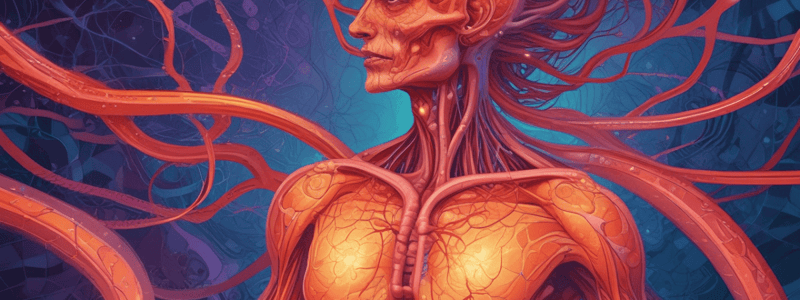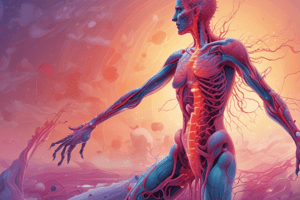Podcast
Questions and Answers
What is the primary purpose of inflammation after an insult, injury, or infection, and how does it contribute to the healing process?
What is the primary purpose of inflammation after an insult, injury, or infection, and how does it contribute to the healing process?
The primary purpose of inflammation is to restore tissue homeostasis and promote healing by removing the harmful stimulus, repairing damaged tissues, and restoring tissue function. It achieves this through increased blood flow, swelling, pain, and heat, which facilitate the delivery of immune cells and molecules to the site of injury.
What is the role of cellular mediators, such as neutrophils and macrophages, in the inflammation mechanism, and how do they interact with chemical mediators?
What is the role of cellular mediators, such as neutrophils and macrophages, in the inflammation mechanism, and how do they interact with chemical mediators?
Cellular mediators, such as neutrophils and macrophages, play a crucial role in the inflammation mechanism by recognizing and eliminating pathogens, removing debris, and producing chemical mediators that amplify the inflammatory response. They interact with chemical mediators, such as cytokines and chemokines, to recruit more immune cells and coordinate the inflammatory response.
How do chemical mediators, such as histamine and bradykinin, influence the inflammation mechanism, and what are their primary effects on blood vessels and smooth muscle?
How do chemical mediators, such as histamine and bradykinin, influence the inflammation mechanism, and what are their primary effects on blood vessels and smooth muscle?
Chemical mediators, such as histamine and bradykinin, influence the inflammation mechanism by increasing blood vessel permeability, dilating blood vessels, and contracting smooth muscle. This leads to increased blood flow, swelling, and pain at the site of injury.
What are the enzymatic inflammation pathways triggered by the lipoxygenase and cyclooxygenase enzymes, and what are the primary products of these pathways?
What are the enzymatic inflammation pathways triggered by the lipoxygenase and cyclooxygenase enzymes, and what are the primary products of these pathways?
What is the role of the products of the lipoxygenase and cyclooxygenase pathways, such as leukotrienes and prostaglandins, in the inflammation mechanism, and how do they contribute to the development of inflammation?
What is the role of the products of the lipoxygenase and cyclooxygenase pathways, such as leukotrienes and prostaglandins, in the inflammation mechanism, and how do they contribute to the development of inflammation?
Study Notes
Inflammation Mechanism
- Inflammation is a protective response to tissue damage or infection, aimed at eliminating the cause and repairing the damage.
- The purpose of inflammation is to:
- Neutralize the insult or infection
- Remove dead cells and debris
- Restore tissue function
Cellular Mediators
- Cellular mediators are immune cells that participate in the inflammation process.
- Key cellular mediators involved in inflammation:
- Neutrophils: early responders, phagocytose pathogens and debris
- Macrophages: clean up debris, present antigens to immune cells
- Lymphocytes: produce chemical mediators, coordinate immune response
- Dendritic cells: recognize pathogens, present antigens to immune cells
- Cellular mediators influence the inflammation mechanism by:
- Phagocytosing pathogens and debris
- Releasing chemical mediators
- Coordinating immune response
Chemical Mediators
- Chemical mediators are molecules that transmit signals between cells during inflammation.
- Key chemical mediators involved in inflammation:
- Histamine: causes vasodilation, increased permeability
- Bradykinin: causes vasodilation, pain
- Prostaglandins: cause pain, fever, vasodilation
- Leukotrienes: attract immune cells, cause increased permeability
- Cytokines: coordinate immune response, attract immune cells
- Chemical mediators influence the inflammation mechanism by:
- Altering blood flow and permeability
- Attracting immune cells
- Coordinating immune response
Enzymatic Inflammation Pathways
Lipoxygenase Pathway
- Triggered by: calcium influx, phospholipase activation
- Products: leukotrienes, lipoxins
- Role of products:
- Leukotrienes: attract immune cells, cause increased permeability
- Lipoxins: resolve inflammation, promote healing
Cyclooxygenase Pathway
- Triggered by: calcium influx, phospholipase activation
- Products: prostaglandins, thromboxanes
- Role of products:
- Prostaglandins: cause pain, fever, vasodilation
- Thromboxanes: cause vasoconstriction, platelet aggregation
Studying That Suits You
Use AI to generate personalized quizzes and flashcards to suit your learning preferences.
Description
Understand the purpose of inflammation, the role of cellular and chemical mediators, and the enzymatic inflammation pathways involved in the inflammation mechanism.




